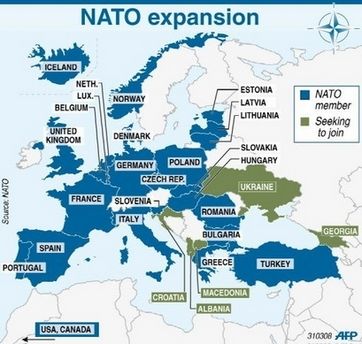I denne artikel vil vi fokusere på hvordan USA udøver sin magt over Europa - og hvorfor.
For det første er det ofte påpeget at NATO er en ren defensiv alliance.
Det er rigtigt at den oprindelige Washington aftale som etablerede NATO i 1949 var fremlagt som en fælles forsvarspagt med vægt på forsvar, sikkerhed og beskyttelse.
Dog er realiteten fra praksis i nyere tid anderledes.
Over de sidste to årtier har et udvidet NATO ført krige mod en række af modstandere på tre kontinenter. Ingen af disse var som et svar på en trussel mod dets medlemslande i Europa eller i Nordamerika.
Der har aldrig været nogen tvivl om hvilket land som dominerer alliancen. .
Fra internationale finansinstitutioner til mlitære alliancer, dem som bidrager med det største indskud kommer uundgåeligt til at kontrollere beslutningsafgørelsen.
Intet sted er det sandere end i NATO, hvor USA er langt den største bidragsyder.
De finansierede næsten 75% af NATOs udgifter - op fra 63% i 2001. Kun tre lande (USA, Storbritannien og Grækenland) møder for tiden NATOs retningslinjer for militærudgifter på 2% af BNP.
Yderligere besidder USA alle militære nøgleposter.
Den civile post som NATOs generalsekretær er traditionalt besat af en Europæer.
Men bortset fra September 2012, hvor en fransk officer blev udpeget til den næsthøjeste post som Overordnet Allierede Kommandør [engelsk: Supreme Allied Commander Transformation], så har de to øverste miliære ledere været amerikanske militærofficerer.
Deres kommandovej går tilbage til Pentagon og det Hvide Hus.
Kommentar:
Vi undskylder at resten af artiklen er på engelsk, men vi må prioritere vores resourcer. Har du lyst til at hjælpe med at oversætte så skriv blot til sott_da@sott.net
Perhaps more importantly, the US holds a virtual monopoly of the instruments of modern high-intensity warfare.
It is the only country with globally based military forces and with the capacity to wage war on land, sea and air against any adversary on the planet.
And despite US complaints that Nato countries need to spend more on defence and share the US "burden," Nato members are encouraged to develop niche or specialist capabilities that complement US facilities rather than duplicating them.
Thus, even the best equipped of European allies, like France or Britain, are highly dependent on the United States for air defence suppression, intelligence, surveillance, target acquisition, reconnaissance and aerial refuelling — a dependency that was exposed during the largely European-led interventions in Libya and Mali.
Nato is the military wing of a much wider project. It exists ultimately to open the world to business for US companies.
This starts in Europe by ensuring that Nato members, old and new, support US values and policies such as free trade, privatisation, deregulation and open economies.
Indeed, much of what Nato does is about eliminating resistance to such policies at home and abroad.
That's why Nato works closely in tandem with the EU.
It is remarkable how the growth of Nato and the EU go hand in hand and step by step.
The European Union implements the policies of what used to be called the "Washington Consensus" on the European continent. Thatcherite neoliberal economics is written into its constitution and is enforced on every member state in virtually every sector of the economy.
Comment: The Washington Consensus "is the set of 10 policies that the US government and the international financial institutions based in the US capital believed were necessary elements of 'first stage policy reform' that all countries should adopt to increase economic growth."
The EU is driving a savage austerity programme across Europe, not just in the highly indebted south, but in almost every other EU member state including Britain.
Just as the United States dominates Nato, it exerts growing influence in the European Union, as that organisation expands east and south across Europe.
The differences that emerged in Nato around the time of the Iraq war — Franco-German versus Anglo-American — have been mirrored in the EU.
And US influence in the EU has been increased by the rapid expansion of the organisation into eastern Europe.
But Britain, often described as the Trojan Horse for the United States, is the key country which facilitates US influence in the EU.
This is the foundation of the "special relationship" by which the elites of the three main Westminster parties, and the SNP in Scotland, hitch their wagons to an Atlanticist strategy in Nato and the EU.
But the US also has a huge stake in the EU's financial system.
The City of London is now dominated by US banks which use the City to access markets across the EU.
By 2011 the stock of US foreign direct investment in the EU amounted to a massive $2.1 trillion.
And the Transatlantic Trade and Investment Partnership (TTIP) currently being negotiated between the EU and the US could remove most of the remaining legislation on the European side which protects environmental, health and safety and trade union rights won over decades of struggle.
Thus the TTIP would comprise a huge transatlantic free-trade market of 850 million people which could cement the power of the US and its transnational companies over much of the Western world.
In short, Nato is a military alliance which was created and expanded by the United States to suit its wider geostrategic interests.
But, as we shall see in the next article, the United States and Nato are far from all-powerful and face a growing challenge to their goal of global domination.






Kommentar: NATO har Europa fanget i et udspekuleret net af gæld, blackmail, korruption og besparelsesforanstaltninger. Resten af verden som kæmper med at vokse i denne korrupte atmosphære prøver at bygge et alternativ. Se: